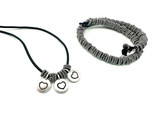Gemstone Index: Jade
For centuries, the word jade applied to green gemstones brought to Europe from China and Central America. It wasn't until 1863 that society realized the term "jade" was being applied to two different minerals. These two gemstones, nephrite and jadeite, are relatively hard to distinguish from each other, and both are still called jade. Varieties of serpentine have also been confused with jade throughout history, and some serpentine is still called jade. In fact, the Chinese word for jade is applied to a variety of minerals that can be carved, including serpentine, agate and quartz!
Our jade beads include true jades, serpentine beads, and beads called "jade" descriptively (because they look like jade). Jade semiprecious beads and pendants are said to increase longevity, and are a symbol of love and virtue.
African Jade: The name African jade is used to describe an opaque grossular garnet that comes from South African mines, and resembles jade. Also known as buddstone, garnet jade, and Transvaal jade, these semiprecious beads often contain a mix of light green, pink and white. The form of grossular garnet they're cut from is a silicate of calcium and aluminum that's used as an inexpensive substitute for jade.
BC Jade and BC-Style Jade: BC jade beads are a beautiful, mossy, medium-green color. The "B.C." stands for British Columbia, which is where real BC jade (a true nephrite jade) is mined. Stock that we know to be actual British Columbian nephrite jade, we have labeled with a "C" (for Canada) at the end of the stock number. Other times we may also have "BC Style Jade" -- these are more likely to be "new jade" (a serpentine), dyed "white jade", and sometimes they may even be "Taiwan jade" (another true nephrite jade, just not from BC). Our BC-Style Jade beads can vary from moss green to nearly emerald green, and from opaque to semi-translucent. Without extensive testing, it is difficult to tell the difference between these stones.
Dendritic Jade: True dendritic jade is olive green to blue-green nephrite with dark dendrites (branching, treelike structures). Like many of the jade beads on the market, we believe our Dendritic jade to be a form of serpentine. (The Chinese word for jade is applied to a variety of minerals, including nephrite, jadeite, serpentine, agate and quartz.). These light green to olive green beads are a nice color match for BC Jade, with the addition of lovely dendritic inclusions in black, dark brown and reddish brown.
Flower Jade (or Madagascar Flower "Jade") is a descriptive name for a pretty stone that appears to be a mix of agate and jasper. Soft pastel shades of opaque and translucent pink, green, lavender, pale blue and cream, intermix with darker shades of copper and coffee. On the larger beads, some of the patterns (like dendritic jade) echo the patterns of tributaries and rivers. Swirls, spots, and occasional flashes of druzy crystal fill the smaller beads.
Green Jade: Our green jade donuts and pendants are carved from a type of serpentine, and vary from pale almost-translucent spring green to olive green and shades of darker pine green. Green jade is a popular stone to use for the heart chakra, in chakra jewelry.
New Jade beads and pendants are cut from bowenite, a type of serpentine that is similar to nephrite jade (often, the specific gravity of the stones must be tested to tell the two apart). These beautiful light green jewelry components complement a number of palettes and complexions!
The Maori people of New Zealand use both bowenite (new jade) and nephrite jade in tools, weapons and ornaments. In China, bowenite is mined in the Soochow (Suzhou) region, hence the other name this semiprecious gemstone is known by, Soochow jade.
Olive Jade: Yellowish-green olive jade beads and pendants are occasionally called peridot stone due to their color (not because of any relationship to that gemstone). Olive jade is actually a form of serpentine, and is not a "true" jade. These semiprecious beads and donuts are softer and less dense than most real jade.
Rainbow New Jade beads are also known as rainbow soochow jade beads, tricolor jade, or occasionally candy jade. Like our other new jade beads, rainbow jade is actually bowenite, a type of serpentine that is similar to nephrite jade. The beautiful color variations in these semiprecious beads are achieved with a colorfast dye, and include delicious fruit shades of raspberry (burgundy), cherry, apricot and green pear. While the colors in these beads will not leech out, make sure to shield the beads from prolonged sun exposure, or the colors may fade. In China, bowenite is mined in the Soochow (Suzhou or Soo Cho) region, thus the name rainbow soochow jade.
Yellow Jade (sometimes called Butterscotch Agate), White Jade and Lime Jade are usually carved from serpentine. Many of these varieties of serpentine "jade" beads and pendants are only available while current supplies last, so don't wait to buy and be sorry later!
Our Bead Blog
-
Simply Springy 2-Hole Bracelet
Apr 28th 2025Designed by: Guest Designer Deb Floros Suggested Supplies 1 #61-840-50-01 Beadalon Cord, WildFire,
-
Exotic Statement Necklace
Apr 28th 2025Designed by: Guest Designer Deb Floros Suggested Supplies 1 #88-400-003-5 58x50mm Pewter Connector,
-
Rubber Tubing Necklace and Memory Wire Bracelet Set
Mar 21st 2025Designed by: Guest Designer Deb Floros Suggested Supplies 1 #61-622-02 2mm Rubber Cord, Bulk, for J



